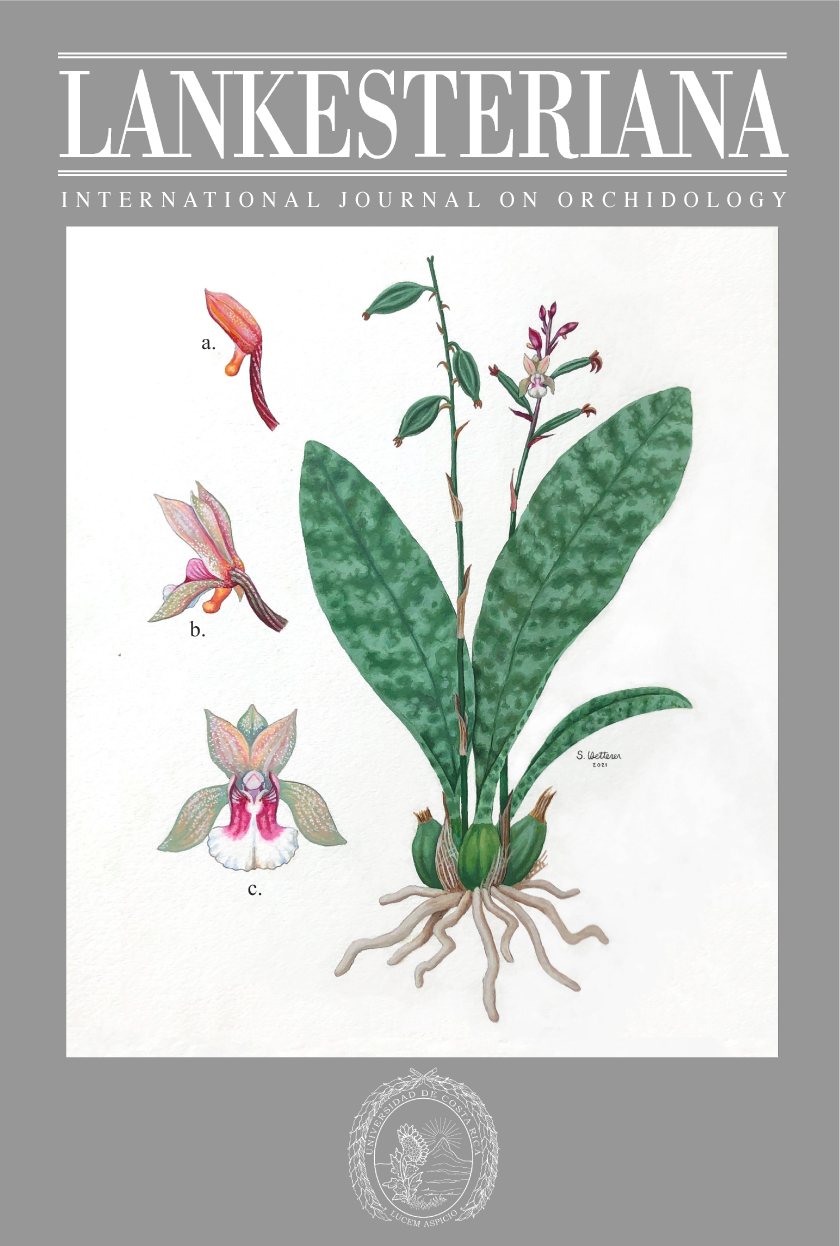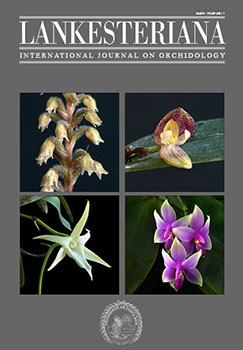Spread of the African spotted orchid <i>Oeceoclades maculata</i> in the New World
DOI:
https://doi.org/10.15517/lank.v22i3.53113Palabras clave:
especie invasora, Eulophia maculata, Oeceoclades, OrchidaceaeResumen
Oeceoclades maculata (Lindl.) Lindl. (= Eulophia maculata (Lindl.) Rchb.f.) has a broad native range across tropical Africa and Madagascar. Here, we document the spread of O. maculata in the New World, using published records, herbarium specimens, photographs posted online, and our own collections. The earliest known New World record of O. maculata is from Brazil dating to before 1790. Until 1962, O. maculata was known in the New World only from South America. Since then, this species has spread north through Central America into Mexico and across the West Indies to Florida and the Bahamas. It was first found in Florida in 1974, and until 1994 all Florida records of O. maculata were restricted to Miami-Dade County (except one record of greenhouse escapees in Gainesville). Here, we document O. maculata records from the following geographic areas in the New World: 11 South American countries (all except Chile and Uruguay), all 7 Central American countries, Mexico, 22 West Indian island-groups, and Florida. We also document records from 31 counties in peninsular Florida. Oeceoclades maculata has now been recorded in the New World from northeastern Rio Grande do Sul, Brazil (~28.5°S) and Estancia Santa Teresa, Corrientes, Argentina (28.0°S) in the south, to Gainesville (29.7°N) and Palm Coast, Florida (29.6°N) in the north. A report of O. maculata populations in Gainesville dying out after a hard frost suggests that this species may have reached its northern outdoor limit in peninsular Florida. Although its impact on native species in the New World appears to be minor, there are efforts to eradicate O. maculata in some natural areas.
Descargas
Citas
Ackerman, J. D. & González-Díaz, N. (2021). Explosive range expansion of Eulophia graminea (Orchidaceae) in Puerto Rico and the West Indies. Lankestriana, 21(3), 307–312. doi: http://dx.doi.org/10.15517/lank.v21i3.48871
Aguiar, J. M. R. B. V., Pansarin, L. M., Ackerman, J. D. & Pansarin, E. R. (2012). Biotic versus abiotic pollination in the Oeceoclades maculata (Lindl.) Lindl. (Orchideaceae). Plant Species Biology, 27, 86–95. doi: https://doi.org/10.1111/j.1442-1984.2011.00330.x
Adamowski, W. (1999). Orchids as Invasive Plants. International Conference on the Ecology of Invasive Alien Plants, 5, 1.
Axelrod, F. S. (2015). A systematic vademecum to the vascular plants of Sint Eustatius. https://www.dutchcaribbeanspecies.org/linnaeus_ng/app/views/literature2/reference.php?id=4353
Balick, M. J., Nee, M. & Atha, D. E. (2000). Checklist of the vascular plants of Belize. Memoirs of the New York Botanical Garden, 85, 1–246.
Bone, R. E., Sanz, E. & Buerki, S. (2014). The transfer of Eulophia beravensis Rchb.f. to Oeceoclades Lindl., a genus with its centre of diversity in Madagascar (Eulophiinae, Orchidaceae). Candollea, 69(2), 201–205. doi: https://doi.org/10.15553/c2014v692a13
Broome, R., Sabir, K., & Carrington, S. (2007). Plants of the Eastern Caribbean. Barbados: University of the West Indies. http://ecflora.cavehill.uwi.edu/index.html [accessed 15 January 2021].
Chipka, S. A. & Izquierdo, J. A. (2005). A new catalogue of Orchidaceae for Saba, N.A. Selbyana, 26, 14–22.doi: https://journals.flvc.org/selbyana/article/view/121351/120123
Cohen, I.M. & Ackerman, J. D. (2009). Oeceoclades maculata, an alien tropical orchid in a Caribbean rainforest. Annals of Botany, 104, 557–563. doi: https://doi.org/10.1093/aob/mcn191
Colla, F. B. (2014). Distribuição e conservação de orquídeas terrestres em florestas subtropicais brasileiras. Dissertação de Mestrado. Universidade Federal do Rio Grande do Sul, Porto Alegre.
Dod, D. D. (1986). Oeceoclades maculata, 1975 a 1985, en una marcha inexorable cruza La Isla Española. Moscosoa, 4, 203–205.
Dodson, C. & Dodson, P. M. (1980). Icones Plantarum Tropicarum: Orchids of Ecuador, serie II, fascicle 5–6. Missouri Botanical Garden, St. Louis.
Dodson, C. H. (1992). Checklist of the orchids of the Western Hemisphere, draft. Missouri Botanical Garden Library, St. Louis.
EDDmapS. (2022). Monk orchid Oeceoclades maculata (Lindl.) Lindl. Early Detection and Distribution Mapping System. The University of Georgia - Center for Invasive Species and Ecosystem Health. https://www.eddmaps.org/distribution/viewmap.cfm?sub=6090 [accessed 12 May 2021]
Gann, G. D., Stocking, C. G., & collaborators. (2022). Oeceoclades maculata (Lindl.) Lindl. Floristic Inventory of South Florida Database Online. The Institute for Regional Conservation. Delray Beach Florida. https://regionalconservation.org/ircs/database/plants/PlantPage.asp?TXCODE=Oecemacu [accessed 3 October 2022]
Garay, L. A. & Taylor, P. (1976). The genus Oeceoclades Lindl. Botanical Museum Leaflets, Harvard University, 24, 249–274.
Gardner, G. (1846). Travels in the interior of Brazil, principally through the northern provinces, and the gold and diamond districts, during the years 1836–1841. Reeve, London: Reeve.
González-Díaz, N. & Ackerman, J. D. (1988). Pollination, fruit set, and seed production in the orchid, Oeceoclades maculata. Lindleyana, 3, 150–155.
Government of Antigua and Barbuda. (2008). Biodiversity inventory and status assessment report for the proposed Wallings Forest Protected Area (Antigua) and the Codrington Lagoon National Park (Barbuda). Island Resources Foundation Washington D.C., USA.
Hágsater, E., Soto Arenas, M. A., Salazar Chavez, G. A., Machorro, R. J., Lopes Rosas, M. A. &
Dressler, R. L. (2005). Las orquideas de Mexico. Productos Famaceutico, S.A. de C.V.,
Mexico.
Hamilton, M. A., Clubbe, C., Robbins, S. K. & Bárrios, S. (2008). Plants and habitats of the Centre Hills and Montserrat. In R. P. Young [ed.] A Biodiversity Assessment of the Centre Hills, Montserrat, Durrell Conservation Monograph, 1, 40–55.
Hammer, R. L. (2001). A status report on the native and naturalized Orchidaceae of Collier, Miami-Dade, and Monroe counties, Florida. North American Native Orchid Journal, 7, 76–77.
Hauman, L. (1917). Quelques Orchidées de l'Argentine. Anales del Museo Nacional de Historia Natural de Buenos Aires, 29, 353–390.
iDigBio. (2021). iDigBio Home Page. https://www.idigbio.org/ [accessed 12 October 2021
Island Resources Foundation. (2015). An Environmental Profile of the Island of Tortola, British Virgin Islands. Addendum I: Preliminary List of Plant Species. Website: http://www.irf.org/an-update-on-the-status-of-bvi-environmental-profiles/environmentalprofiletortola_addendum_1_preliminaryplantlist_2015/ [accessed 5 May 2021]
Island Resources Foundation. (2015). An environmental profile of the island of Tortola, British Virgin Islands. Island Resources Foundation. Addendum I: Preliminary list of plant species. Tortola, BVI and Washington, DC. http://www.irf.org/wp-content/uploads/2015/10/EnvironmentalProfileTortola_ADDENDUM_1_PreliminaryPlantList_2015.pdf [accessed 26 October 2021]
iNaturalist. (2021). Monk orchid (Oeceoclades maculata). https://www.inaturalist.org/observations?place_id=any&subview=table&taxon_id=140483 [accessed 3 October 2022]
Kolanowska, M. (2014). The naturalization status of African Spotted Orchid (Oeceoclades maculata) in Neotropics. Plant Biosystems, 148, 1049–1055.
Lindley, J. (1821). Collectanea Botanica; or Figures and Botanical Illustrations of Rare and Curious Exotic Plants, Chiefly Cultivated in the Gardens of Great Britain. Richard and Arthur Taylor, London.
Lindsay, K., Mussington, J., & Bacle, J.-P. (2008). Biodiversity inventory and status assessment report for the proposed Wallings Forest Protected Area (Antigua) and the Codrington Lagoon National Park (Barbuda). Government of Antigua and Barbuda. http://www.irf.org/wp-content/uploads/2015/10/Wallings-CodringtonBiodiversitySurvey_Antigua_2008.pdf
Link, J. H. F., & Otto, C. F. (1821). Icones Plantarum Selectarum Horti Regii Botanici Berolinensis cum descriptionibus et colendi ratione, fascicle 3. Berolini, Berlin.
Naturalis Biodiversity Center. (2021). Monk Orchid Oeceoclades maculata. Dutch Caribbean Species Register. www.dutchcaribeanspecies.org [accessed 3 January 2021].
Peel, M. C., Finlayson, B. L. & McMahon, T. A. (2007). Updated world map of the Köppen-Geiger climate classification. Hydrology and Earth System Sciences, 11, 1633–1644. doi: https://doi.org/10.5194/hess-11-1633-2007
Pemberton, R. W. (2013). Rapid geographic spread of the alien orchid Eulophia graminea in Florida. Selbyana, 31(1), 47–51. doi: https://journals.flvc.org/selbyana/article/view/122971
PNUD (Programa de las Naciones Unidas para el Desarrollo, México). (2017). Plan de Monitoreo y Control de la orquídea africana (Oeceoclades maculata) en la Reserva de la Biósfera Los Tuxtlas. Proyecto 089333 “Aumentar las Capacidades Nacionales para el Manejo de las Especies Exóticas Invasoras (EEI) a través de la Implementación de la Estrategia Nacional de EEI”. 17 pp. + 1 Anexo. Vega-Rodríguez, B. I., Terán-González, G. J., Luna-Aguilar, L. A. y G. E. Martínez-Romero. Fomento Ecológico y Social A. C. Veracruz, México.
Proctor, G. R. (1996). Additions and corrections to 'Flora of the Cayman Islands'. Kew Bulletin, 51 (3), 483–507.
Proosdij, A. S. J. van. (2012). Arnoldo’s Zakflora. Wat in het wild groeit en bloeit op Aruba,
Bonaire, en Curaçao. 4th revised edition. Walburg Pers, Zutphen, Netherlands.
Robinson, D. J., Gandy, E., VanHoek, C. & Pemberton, R. W. (2011). Naturaliztion of the Nun’s Hood orchid (Phatus tankervilleae: Orchidaceae) in Central Florida. Journal of the Botanical Research Institute of Texas, 5(1), 337–339.
Stern, W.L. (1988). The long-distance dispersal of Oeceoclades maculata. American Orchid Society Bulletin, 57, 960–971.
Tropicos.org. (2021). Oeceoclades maculata (Lindl.) Lindl. Missouri Botanical Garden. https://tropicos.org/name/23512591 [accessed 15 January 2021]
Ueno, S., Rodrigues, J. F., Alves-Pereira, A., Pansarin, E. R. & Veasey, E. A. (2015). Genetic variability within and among populations of an invasive, exotic orchid. AoB PLANTS, 7, plv077, https://doi.org/10.1093/aobpla/plv077
Valdez, L. (2020). Oeceoclades maculata [video] https://www.youtube.com/watch?v=ep6tUFJrqmo [accessed 6 May 2021].
Vellozo, J. M. C. (1831). (imprint 1827). Florae Fluminensis icones. 9: Tab. 44. Senefelder, curante J. Knecht, Paris, France.
Vellozo, J. M. C. (1881). Flora Fluminensis. Flumine Januario, Machado, Brazil.
Wunderlin, R. P., Hansen, B. F., Franck, A. R. & Essig, F. B. (2021). Oeceoclades maculata. Atlas of Florida plants. [S. M. Landry and K. N. Campbell (application development), USF Water Institute.] Institute for Systematic Botany, University of South Florida, Tampa. http://florida.plantatlas.usf.edu/Plant.aspx?id=1327 [accessed 8 June 2021]

Descargas
Publicado
Cómo citar
Número
Sección
Licencia
Derechos de autor 2022 Jardín Botánico Lankester, Universidad de Costa Rica

Esta obra está bajo una licencia internacional Creative Commons Reconocimiento-NoComercial-SinObraDerivada 3.0.
Conforme con las Políticas de Acceso Abierto promovidas por la Universidad de Costa Rica, los derechos de autor de todos los artículos publicados en Lankesteriana se encuentran bajo una licencia Creative Commons y pueden ser descargados gratuitamente. Los derechos de autor y de publicación pertenecen a la revista bajo la licencia CC BY-NC-ND 3.0 CR.
Before the publication of the materials submitted by the author(s) in LANKESTERIANA, the author(s) hereby assign all rights in the article to the Lankester Botanical Garden.




